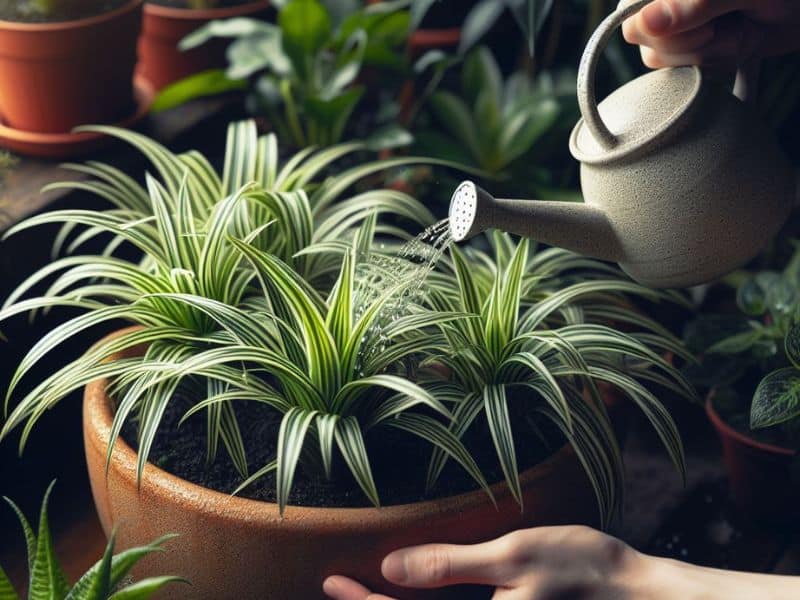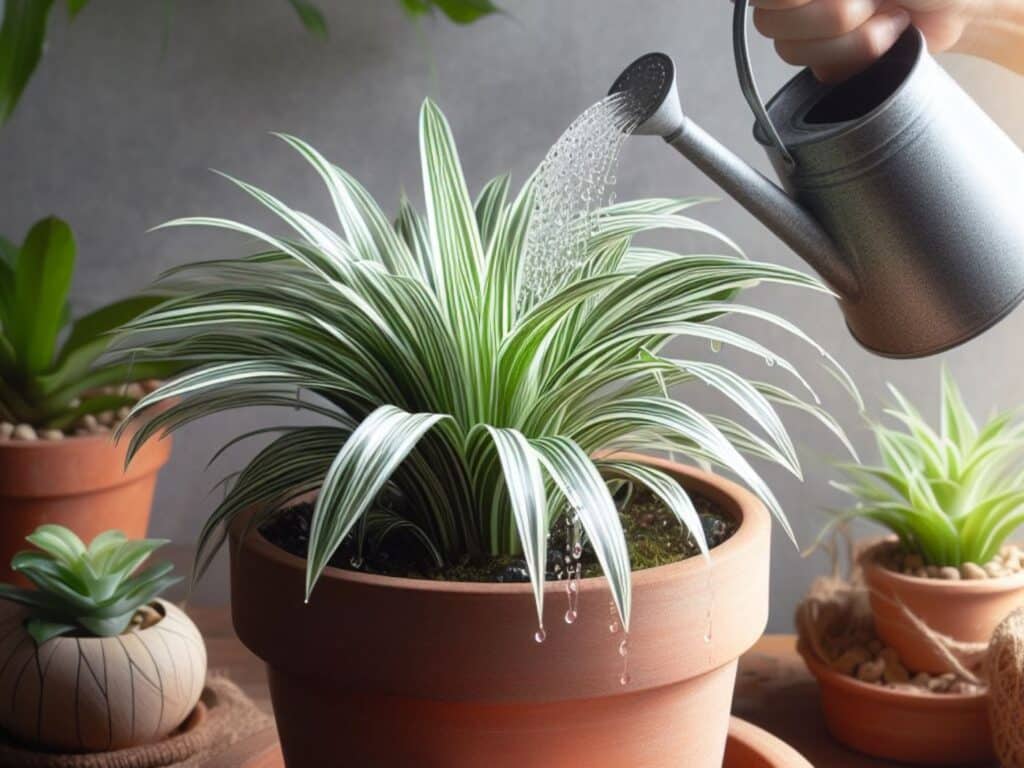Imagine discovering your spider plant, once vibrant and thriving, now appears limp, its leaves losing their lush green vigor. This common scenario often leaves plant enthusiasts puzzled and concerned.
Overwatering, a frequent oversight, can silently afflict your spider plant, leading to various health issues that undermine its growth and beauty. Understanding the signs of overwatering, its reasons, and how to effectively address it is crucial for reviving your plant and restoring its vitality.
This article delves into the heart of the problem, offering insights and solutions to help you nurse your overwatered spider plant back to health. Let’s explore how you can identify the symptoms, understand the causes, and implement the right remedies to ensure your spider plant flourishes once again.
Signs of an Overwatered Spider Plant
Recognizing the signs of an overwatered spider plant is crucial for its recovery. The symptoms are not just a call for help but a guideline on how to assist your plant. Let’s dive into these signs and see how you can spot them.
Wilting and Yellowing Leaves
Ironically, overwatered spider plants often look thirsty. Their leaves wilt and turn yellow, despite the soil being wet. This yellowing usually starts at the tips before spreading throughout the leaf.
If you notice this, it’s a clear indication that your plant’s watering schedule needs a rethink. Remember, spider plants like their soil to dry out a bit between waterings.
Root Rot and Mushy Base
Root rot is a silent killer for spider plants. It starts beneath the soil, making it hard to detect until it’s fairly advanced. You’ll know it’s there when you feel a mushy base upon gently touching the plant’s root area.
Also, a foul smell emanating from the pot is a giveaway. If you encounter this, immediate action is essential. Root rot can spread quickly, endangering the entire plant.
Stunted Growth and Leaf Drop
A spider plant thriving makes new growth and occasionally drops old leaves. However, an overwatered one drops leaves at an alarming rate while showing little to no new growth. This stunted growth, combined with frequent leaf drop, signals that the plant is in distress. Your spider plant is literally shedding the excess water it cannot handle.
If your spider plant is displaying any of these symptoms, it’s time for some plant first aid. Adjusting your watering habits, ensuring proper drainage, and maybe even repotting in severe cases can help your spider plant bounce back. Remember, it’s all about giving your plant what it needs, no more, no less.
Reasons Why Spider Plants Get Overwatered

Improper Watering Schedule
You may well think giving your spider plant a drink whenever you remember is a good idea, but that’s where you’re going wrong. These plants dislike soggy feet. Overwatering happens when enthusiasm outstrips necessity.
Keep a check on your watering routine—it’s not about quantity but timing. During cooler months, spider plants need less water. Trust the topsoil; if it’s dry an inch deep, it’s time for hydration.
Inadequate Drainage
If your spider plant’s pot is more like a swimming pool, you’ve found another culprit for overwatering. Good drainage is essential; without it, water accumulates, spellcasting root rot.
Ensure your pot has sufficient drainage holes. If water sits at the bottom, consider a pot switch or adding more holes. A well-draining potting mix also helps. It’s about facilitating a quick getaway for excess water.
Environmental Factors
Lastly, don’t underestimate the power of where your plant lives. Overwatering isn’t just about how much water you give but also how fast it evaporates. High humidity and low light slow down evaporation, leaving your plant wetter, longer.
Spider plants love bright, indirect light and moderate humidity. If your plant’s environment feels more like a rainforest than a comfortable living room, it may well be time for a relocation. Adjusting your plant’s location could be the simple fix you need to stop overwatering.
Preventive Measures for Overwatering
Preventing overwatering in your spider plant involves more than just cutting back on how often you water. It’s about creating the right environment that mimics its natural habitat as closely as possible. Here’s how you can do just that.
Assessing Soil Moisture
Let’s start with the basics. Checking the soil moisture is like checking the weather before you leave your house. You wouldn’t carry an umbrella on a sunny day, right? Similarly, stick your finger about an inch deep into the soil.
If it feels dry, your plant is telling you it’s thirsty. But if it’s damp, hold off on watering. Spider plants are pretty low maintenance, but they’re not fans of wet feet. If you’re tech-savvy, a soil moisture meter can become your best friend here, giving you a more precise reading of when to water.
Using the Right Potting Mix
Choosing the correct potting mix for your spider plant is like picking the right foundation for your home. Just any old soil won’t do. You need a mix that drains well yet retains enough moisture to keep the plant happy.
A blend of peat, perlite, and vermiculite often hits the mark, providing the perfect balance for your spider plant. This mix allows roots to breathe and water to flow through, preventing that dreaded waterlog situation.
Choosing the Correct Pot Size
Size really does matter when it comes to pots. A pot that’s too large for your spider plant may well seem like you’re giving it room to grow, but in reality, it’s an open invitation for excess water to accumulate.
Here’s a pro tip: pick a pot that’s just the right size for your plant’s current root ball plus a little extra room to grow. This way, the soil can dry out more evenly between waterings, reducing the risk of overwatering. Remember, a well-fitting pot is like a cozy home, offering just enough space to thrive without drowning in excess.
By focusing on these aspects, you can create an environment that keeps your spider plant healthy, vibrant, and, most importantly, not overwatered.
Steps to Revive an Overwatered Spider Plant
Inspecting and Trimming the Roots
First, gently remove your spider plant from its pot and examine the roots carefully. Healthy roots are firm and white, while those affected by overwatering may appear brown and mushy.
Snip off any damaged roots with clean, sharp scissors. Doing so prevents the spread of root rot and gives the plant a better chance at recovery.
Repotting with Fresh Soil
After trimming the roots, it’s time to give your plant a fresh start. Choose a pot with adequate drainage holes. Opt for a potting mix that promotes good drainage – a mixture of peat, vermiculite, and perlite works wonders. This step ensures your spider plant won’t sit in waterlogged soil, reducing the risk of future overwatering.
Adjusting Watering Habits
Finally, reassess your watering routine. Spider plants prefer the soil to dry out slightly between watering. Stick your finger into the soil up to the second knuckle; if it feels dry, it’s time to water. Remember, it’s better to under-water than over-water.
Adapting your watering habits is crucial to prevent another overwatering mishap. This change may well seem small, but it makes a huge difference in keeping your spider plant healthy and thriving.
See more: Overwatered Elephant Ear Plant: How to Revive and Prevent Damage







